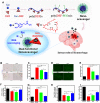Nanomedicine: An Emerging Novel Therapeutic Strategy for Hemorrhagic Stroke
- PMID: 35530973
- PMCID: PMC9075782
- DOI: 10.2147/IJN.S357598
Nanomedicine: An Emerging Novel Therapeutic Strategy for Hemorrhagic Stroke
Abstract
Hemorrhagic stroke is one of the most devastating diseases worldwide due to a high rate of disability and mortality with few effective treatments. Recent advances in nanomedicines to promote hemostasis, drug delivery, neuroprotection, and nerve regeneration may provide insight into hemorrhagic stroke treatment. In this review, we first view the pathophysiology and conventional therapeutics of hemorrhagic stroke. Second, we comprehensively summarize the current nanomedicines applied in hemorrhagic stroke, including inorganic nanomaterials, polymer-based nanomaterials, lipid-based nanomaterials, self-assembling peptide-based hydrogel, exosomes, and gel systems. Finally, the challenges, opportunities, and future perspectives of nanomedicines for hemorrhagic stroke are discussed. Thus, this review promotes greater exploration of effective therapies for hemorrhagic stroke with nanomedicines.
Keywords: hemorrhagic stroke; intracerebral hemorrhage; nanomedicine; subarachnoid hemorrhage; therapy.
© 2022 Xu et al.
Conflict of interest statement
The authors report no conflicts of interest in this work.
Figures





Similar articles
-
Polyprodrug Nanomedicines: An Emerging Paradigm for Cancer Therapy.Adv Mater. 2022 Feb;34(6):e2107434. doi: 10.1002/adma.202107434. Epub 2021 Dec 22. Adv Mater. 2022. PMID: 34693571 Review.
-
Cancer-associated-platelet-inspired nanomedicines for cancer therapy.Wiley Interdiscip Rev Nanomed Nanobiotechnol. 2021 Sep;13(5):e1702. doi: 10.1002/wnan.1702. Epub 2021 Feb 3. Wiley Interdiscip Rev Nanomed Nanobiotechnol. 2021. PMID: 33538125 Review.
-
Nanomedicine progress in thrombolytic therapy.Biomaterials. 2020 Nov;258:120297. doi: 10.1016/j.biomaterials.2020.120297. Epub 2020 Aug 6. Biomaterials. 2020. PMID: 32818824 Review.
-
Disposition and safety of inhaled biodegradable nanomedicines: Opportunities and challenges.Nanomedicine. 2016 Aug;12(6):1703-24. doi: 10.1016/j.nano.2016.03.002. Epub 2016 Mar 23. Nanomedicine. 2016. PMID: 27033834 Review.
-
New challenges in the use of nanomedicine in cancer therapy.Bioengineered. 2022 Jan;13(1):759-773. doi: 10.1080/21655979.2021.2012907. Bioengineered. 2022. PMID: 34856849 Free PMC article.
Cited by
-
Nanobiotechnologies for stroke treatment.Nanomedicine (Lond). 2025 Jun;20(11):1299-1319. doi: 10.1080/17435889.2025.2501514. Epub 2025 May 6. Nanomedicine (Lond). 2025. PMID: 40327588 Review.
-
Application and Development of Cell Membrane Functionalized Biomimetic Nanoparticles in the Treatment of Acute Ischemic Stroke.Int J Mol Sci. 2024 Aug 5;25(15):8539. doi: 10.3390/ijms25158539. Int J Mol Sci. 2024. PMID: 39126107 Free PMC article. Review.
-
Elucidating the progress and impact of ferroptosis in hemorrhagic stroke.Front Cell Neurosci. 2023 Jan 11;16:1067570. doi: 10.3389/fncel.2022.1067570. eCollection 2022. Front Cell Neurosci. 2023. PMID: 36713782 Free PMC article. Review.
-
Unveiling the role of stress hyperglycemia in predicting mortality for critically ill hemorrhagic stroke patients: insights from MIMIC-IV.Front Endocrinol (Lausanne). 2025 May 2;16:1558352. doi: 10.3389/fendo.2025.1558352. eCollection 2025. Front Endocrinol (Lausanne). 2025. PMID: 40385356 Free PMC article.
-
Endoscopic nasal delivery of engineered endothelial progenitor cell-derived exosomes improves angiogenesis and neurological deficits in rats with intracerebral hemorrhage.Mater Today Bio. 2025 Mar 11;32:101652. doi: 10.1016/j.mtbio.2025.101652. eCollection 2025 Jun. Mater Today Bio. 2025. PMID: 40160244 Free PMC article.
References
-
- Mendelow AD, Gregson BA, Fernandes HM, et al. Early surgery versus initial conservative treatment in patients with spontaneous supratentorial intracerebral haematomas in the International Surgical Trial in Intracerebral Haemorrhage (STICH): a randomised trial. Lancet. 2005;365(9457):387–397. doi:10.1016/S0140-6736(05)70233-6 - DOI - PubMed
Publication types
MeSH terms
Substances
LinkOut - more resources
Full Text Sources
Medical

